TOYOTA YARIS HATCHBACK 2009 Owners Manual
Manufacturer: TOYOTA, Model Year: 2009, Model line: YARIS HATCHBACK, Model: TOYOTA YARIS HATCHBACK 2009Pages: 402, PDF Size: 7.61 MB
Page 331 of 402
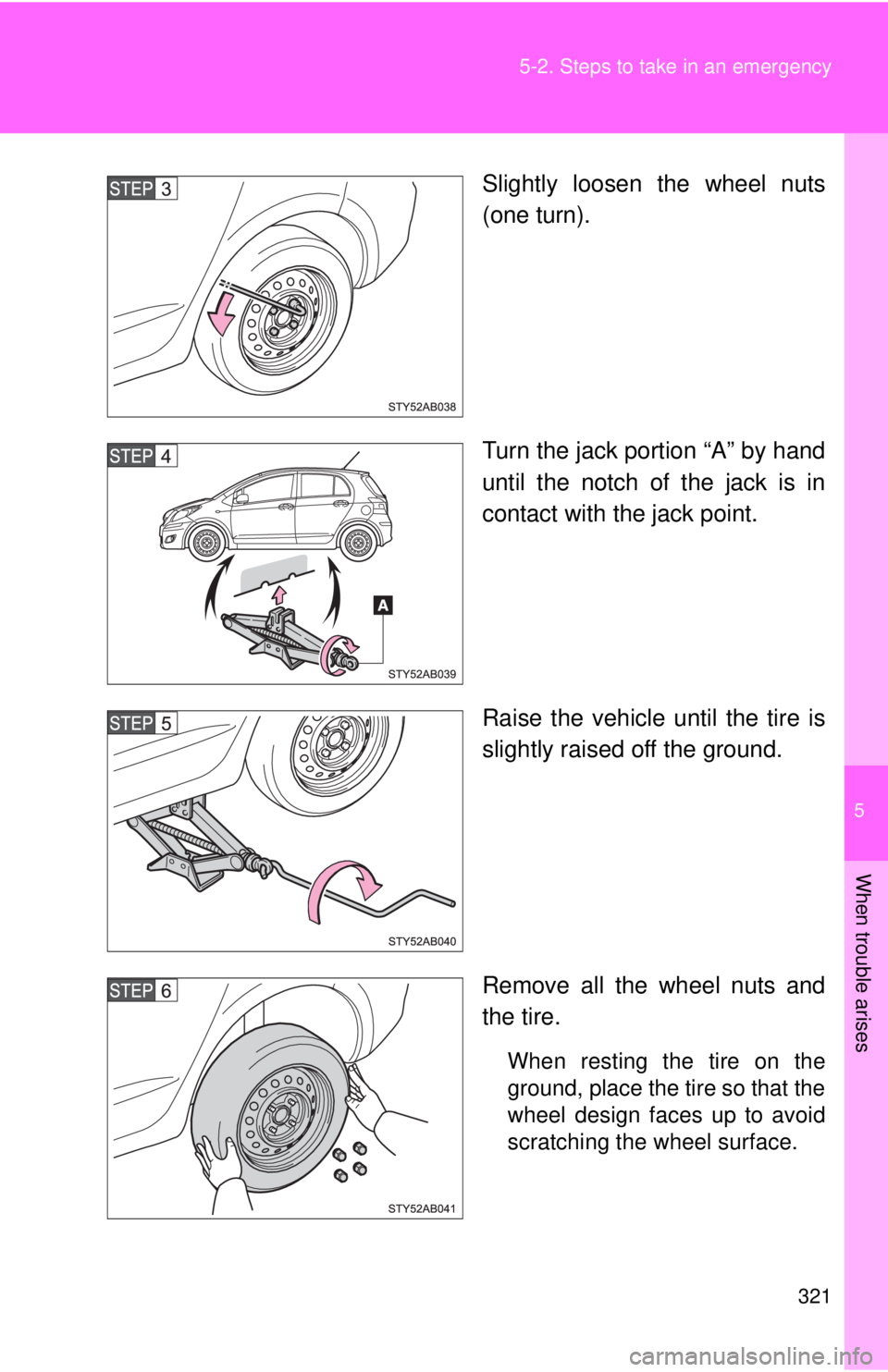
5
When trouble arises
321
5-2. Steps to take in an emergency
Slightly loosen the wheel nuts
(one turn).
Turn the jack portion “A” by hand
u
ntil the notch of the jack is in
contact with the jack point.
Raise the vehicle until the tire is
slightly raised of
f the ground.
Remove all the wheel nuts and
the tire.
When resting the tire on the
ground, place the tire so that the
wheel design faces up to avoid
scratching the wheel surface.
Page 332 of 402
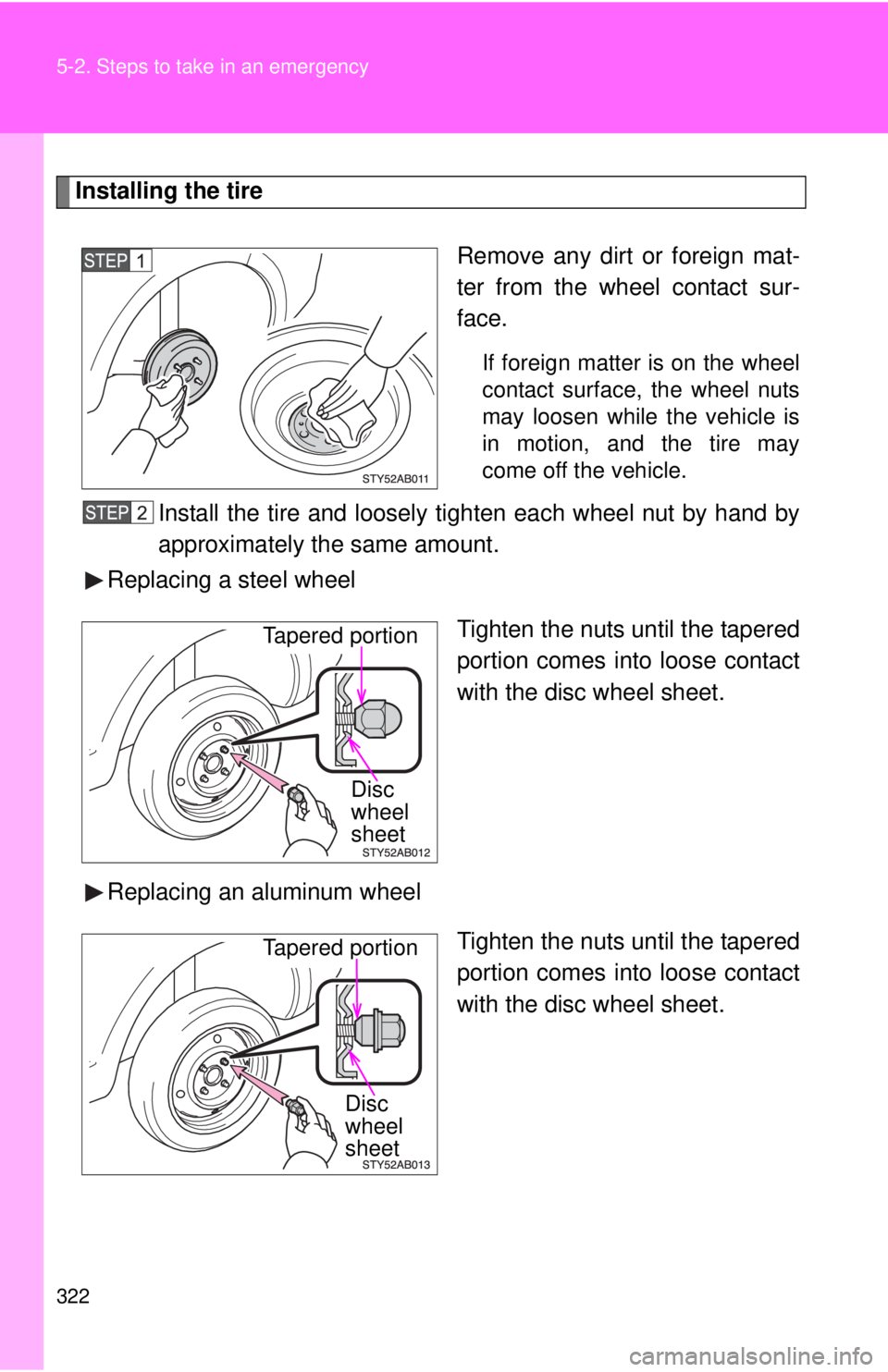
322 5-2. Steps to take in an emergency
Installing the tire
Remove any dirt or foreign mat-
ter from the wheel contact sur -
face.
If foreign matter is on the wheel
contact surface, the wheel nuts
may loosen while the vehicle is
in motion, and the tire may
come off the vehicle.
Install the tire and loosely tigh ten each wheel nut by hand by
approximately the same amount.
Replacing a steel wheel
Tighten the nuts until the tapered
p
ortion comes into loose contact
with the disc wheel sheet.
Replacing an aluminum wheel Tighten the nuts until the tapered
p
ortion comes into loose contact
with the disc wheel sheet.
Disc
wheel
sheet
Tapered portion
Disc
wheel
sheet
Tapered portion
Page 333 of 402
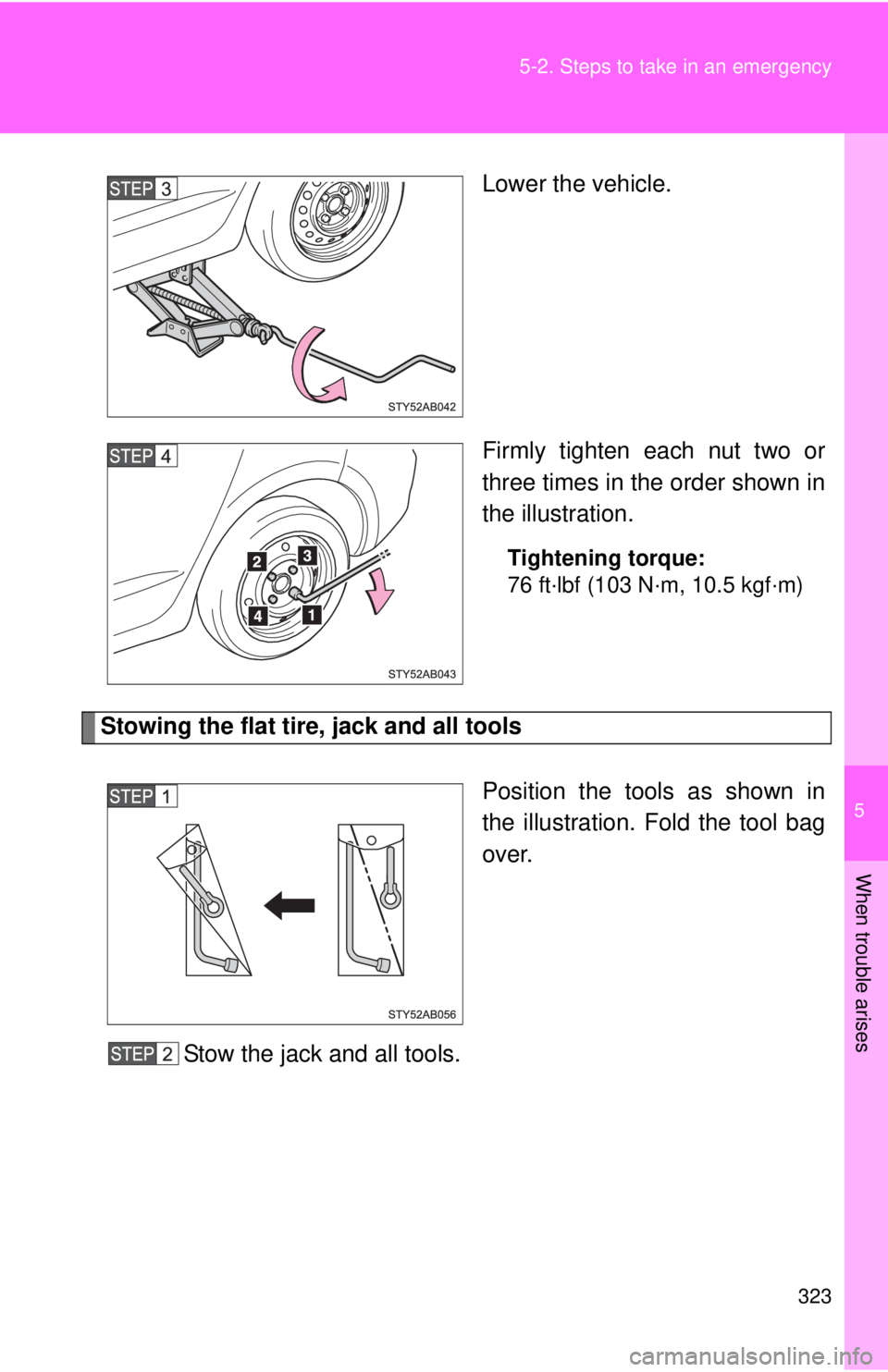
5
When trouble arises
323
5-2. Steps to take in an emergency
Lower the vehicle.
Firmly tighten each nut two or
thr
ee times in the order shown in
the illustration.
Tightening torque:
76 ft·lbf (103 N·m, 10.5 kgf·m)
Stowing the flat tire, jack and all tools
Position the tools as shown in
the illustration. Fold the tool bag
over.
Stow the jack and all tools.
Page 334 of 402
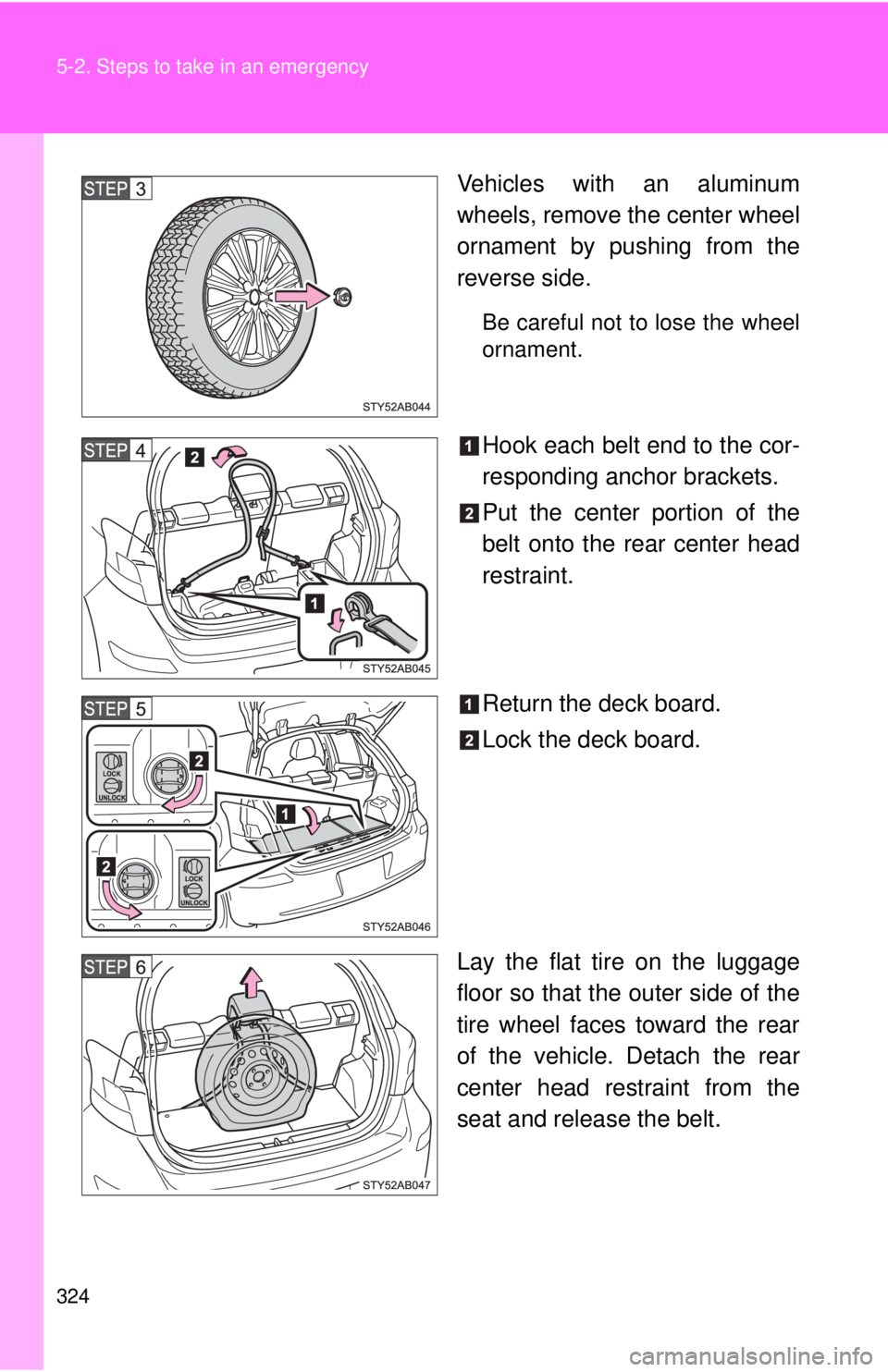
324 5-2. Steps to take in an emergency
Vehicles with an aluminum
wheels, remove the center wheel
ornament by pushing from the
reverse side.
Be careful not to lose the wheel
ornament.
Hook each belt end to the cor-
responding anchor brackets.
Put the center portion of the
belt onto the rear center head
re
straint.
Return the deck board.
Lock the deck board.
Lay the flat tire on the luggage
floo
r so that the outer side of the
tire wheel faces toward the rear
of the vehicle. Detach the rear
center head restraint from the
seat and release the belt.
Page 335 of 402
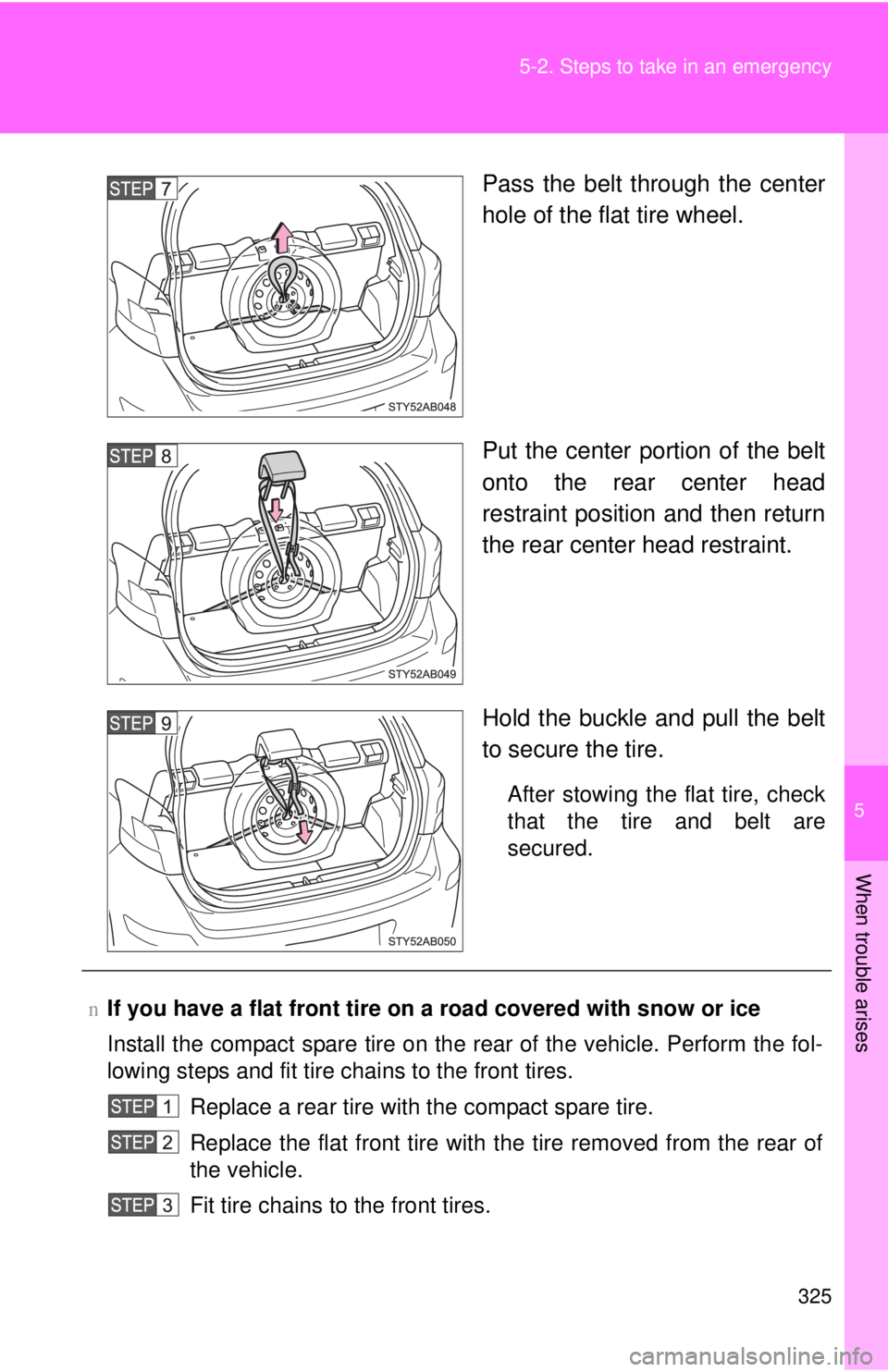
5
When trouble arises
325
5-2. Steps to take in an emergency
Pass the belt through the center
hole of the flat tire wheel.
Put the center portion of the belt
o
nto the rear center head
restraint position and then return
the rear center head restraint.
Hold the buckle and pull the belt
t
o secure the tire.
After stowing the flat tire, check
that the tire and belt are
secured.
nIf you have a flat front tire on a road covered with snow or ice
Install the compact spare tire on the rear of the vehicle. Perform the fol -
lowing steps and fit tire chains to the front tires.
Replace a rear tire with the compact spare tire.
Replace the flat front tire with t he tir
e removed from the rear of
the vehicle.
Fit tire chains to the front tires.
Page 336 of 402
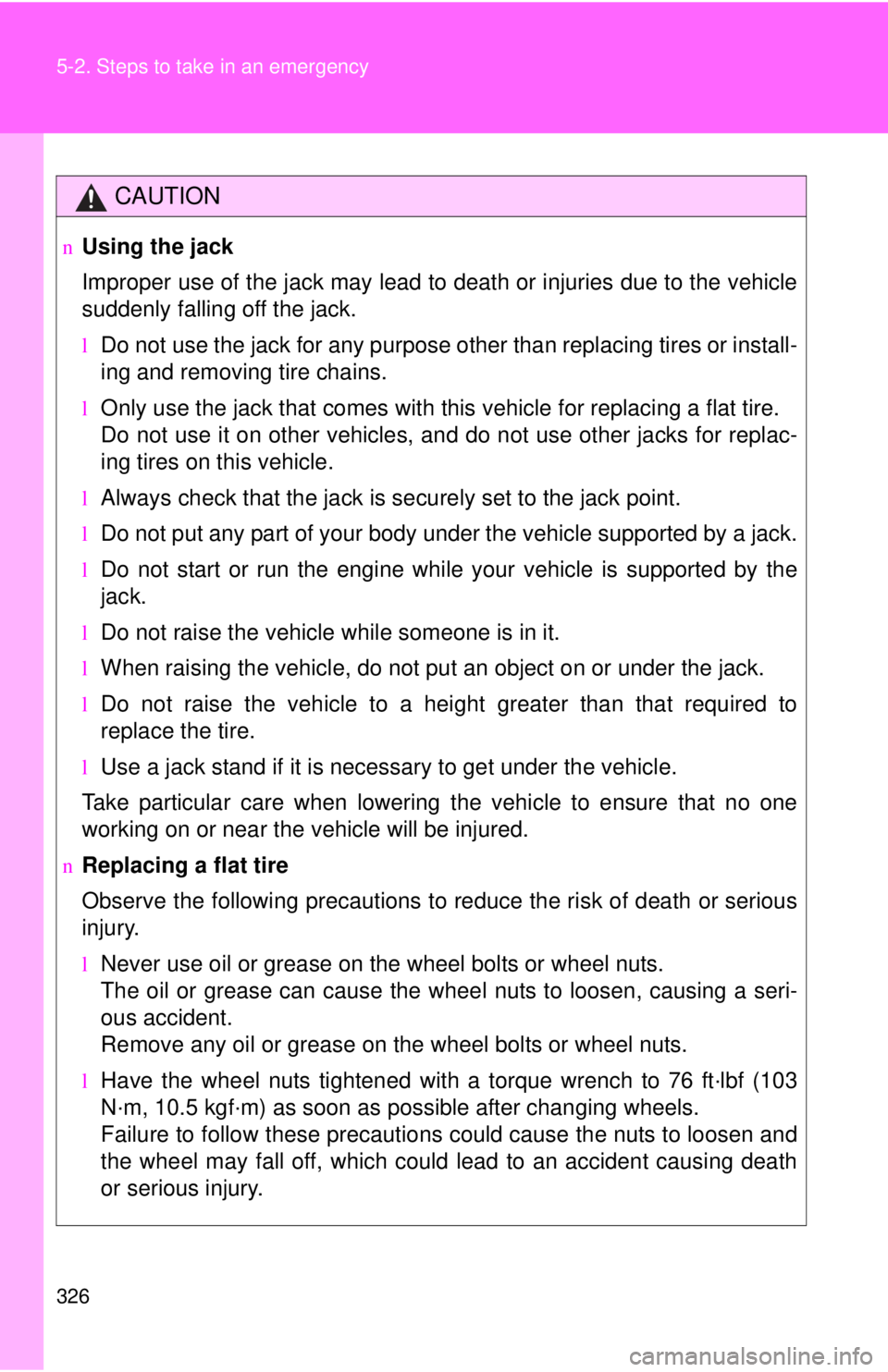
326 5-2. Steps to take in an emergency
CAUTION
nUsing the jack
Improper use of the jack may lead to death or injuries due to the vehicle
suddenly falling off the jack.
lDo not use the jack for any purpose other than replacing tires or install-
ing and removing tire chains.
lOnly use the jack that comes with this vehicle for replacing a flat tire.
Do not use it on other vehicles, an d do not use other jacks for replac-
ing tires on this vehicle.
lAlways check that the jack is securely set to the jack point.
lDo not put any part of your body under the vehicle supported by a jack.
lDo not start or run the engine while your vehicle is supported by the
jack.
lDo not raise the vehicle while someone is in it.
lWhen raising the vehicle, do not put an object on or under the jack.
lDo not raise the vehicle to a heigh t greater than that required to
replace the tire.
lUse a jack stand if it is necessary to get under the vehicle.
Take particular care when lowering the vehicle to ensure that no one
working on or near the vehicle will be injured.
nReplacing a flat tire
Observe the following precautions to reduce the risk of death or serious
injury.
lNever use oil or grease on the wheel bolts or wheel nuts.
The oil or grease can cause the wheel nuts to loosen, causing a seri-
ous accident.
Remove any oil or grease on the wheel bolts or wheel nuts.
lHave the wheel nuts tightened with a torque wrench to 76 ft·lbf (103
N·m, 10.5 kgf·m) as soon as possible after changing wheels.
Failure to follow these precautions could cause the nuts to loosen and
the wheel may fall off, which could lead to an accident causing death
or serious injury.
Page 337 of 402
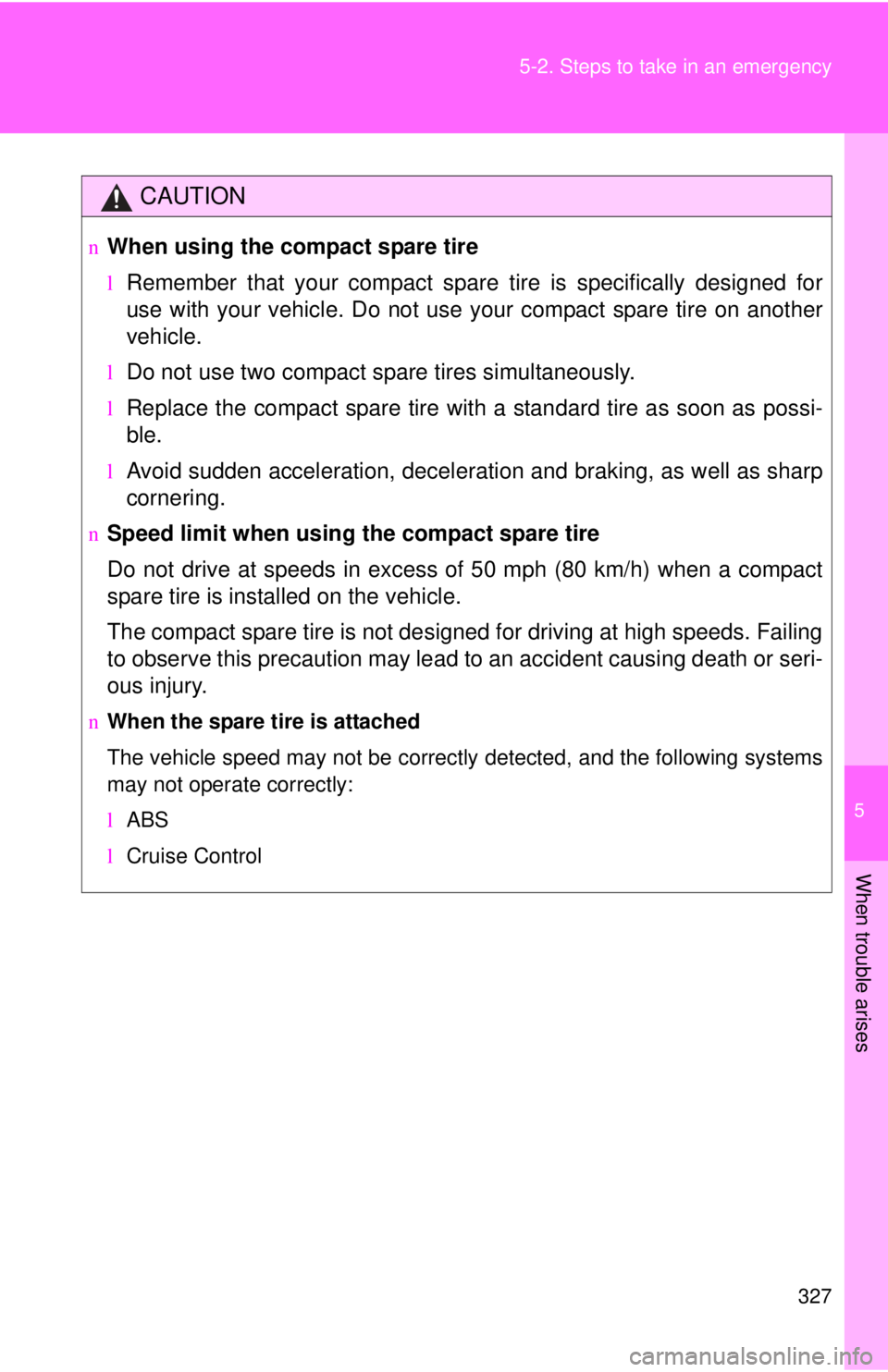
5
When trouble arises
327
5-2. Steps to take in an emergency
CAUTION
nWhen using the compact spare tire
lRemember that your compact spare
tire is specifically designed for
use with your vehicle. Do not use your compact spare tire on another
vehicle.
lDo not use two compact spare tires simultaneously.
lReplace the compact spare tire with a standard tire as soon as possi-
ble.
lAvoid sudden acceleration, deceleration and braking, as well as sharp
cornering.
nSpeed limit when using the compact spare tire
Do not drive at speeds in excess of 50 mph (80 km/h) when a compact
spare tire is installed on the vehicle.
The compact spare tire is not designed for driving at high speeds. Failing
to observe this precaution may lead to an accident causing death or seri-
ous injury.
n When the spare tire is attached
The vehicle speed may not be correctly detected, and the following systems
may not operate correctly:
lABS
l Cruise Control
Page 338 of 402

328 5-2. Steps to take in an emergency
NOTICE
nDo not drive the vehicle with a flat tire.
Do not continue driving with a flat tire.
Driving even a short distance with a flat tire can damage the tire and the
wheel beyond repair.
nBe careful when driving over bumps with the compact spare tire
installed on the vehicle.
The vehicle becomes lower when driving with the compact spare tire
compared to when drivin g with standard tires. Be careful when driving
over uneven road surfaces.
nDriving with tire chains and the compact spare tire
Do not fit tire chains to the compact spare tire.
Tire chains may damage the vehicle body and adversely affect driving
performance.
nWhen replacing the tires
lWhen removing or fitting the wheels, tires or the tire pressure warning
valve and transmitter, contact your Toyota dealer as the tire pressure
warning valve and transmitter may be damaged if not handled cor-
rectly.
lReplace the grommets for the tire pressure warning valves and trans-
mitters as well.
nTo avoid damaging the tire pressure warning valves and transmit-
ters
Do not use liquid sealants on flat tires.
Page 339 of 402
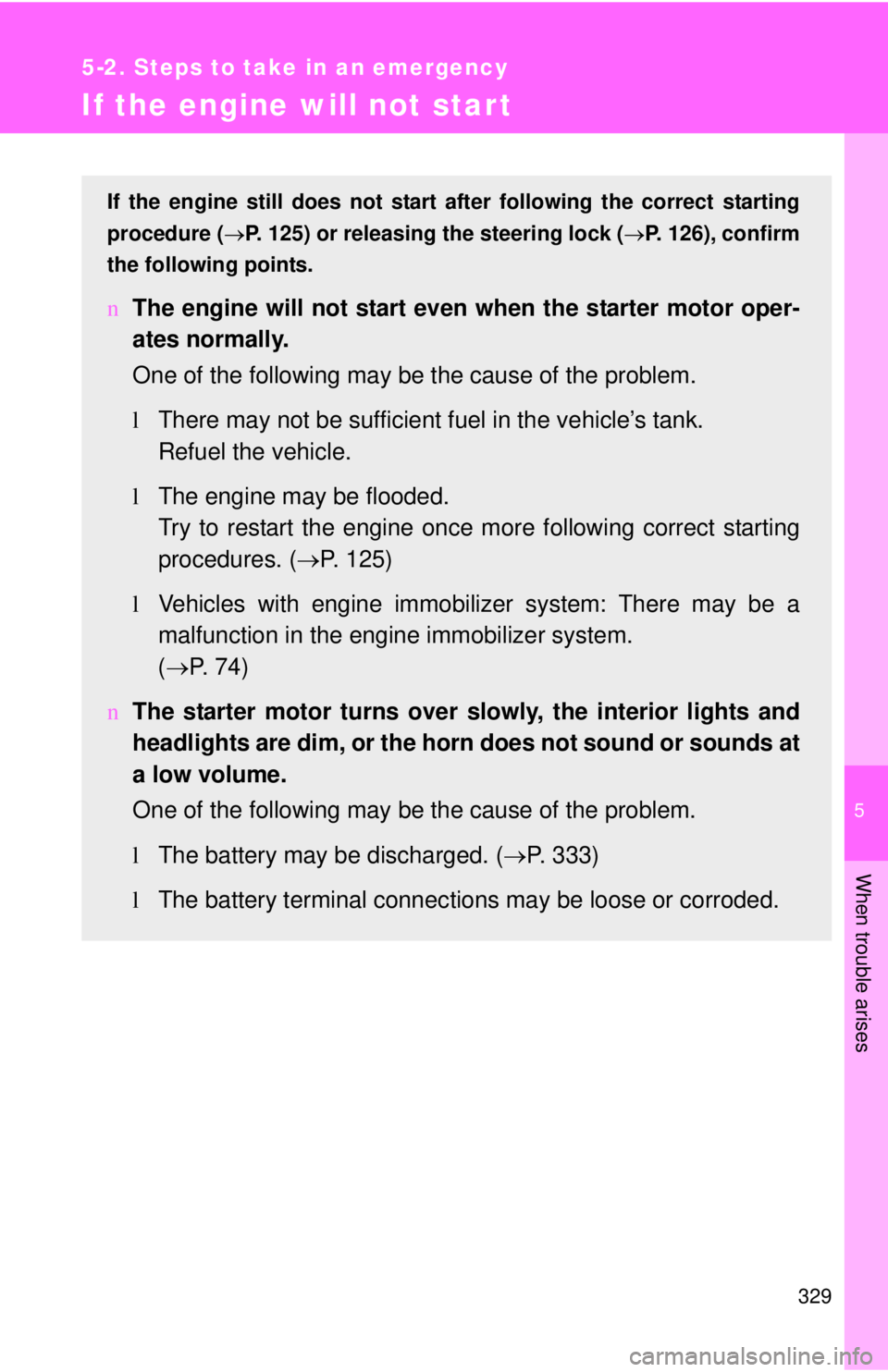
5
When trouble arises
329
5-2. Steps to take in an emergency
If the engine will not start
If the engine still does not start after following the correct starting
procedure ( →
P. 125) or releasing the steering lock ( →P. 126), confirm
the following points.
n The engine will not start even when the starter motor oper -
ates normally.
One of the following may be the cause of the problem.
l There
may not be sufficient fuel in the vehicle’s tank.
Refuel the vehicle.
l The eng
ine may be flooded.
Try to restart the engine once more following correct starting
pro
cedures. ( →P. 125 )
l V
ehicles with engine immobilizer system: There may be a
malfunction in the engine immobilizer system.
( → P. 7 4 )
n The
starter motor turns over slowly, the interior lights and
headlights are dim, or the horn does not sound or sounds at
a low volume.
One of the following may be the cause of the problem.
lThe battery
may be discharged. (→ P. 333)
l The
battery terminal connec tions may be loose or corroded.
Page 340 of 402
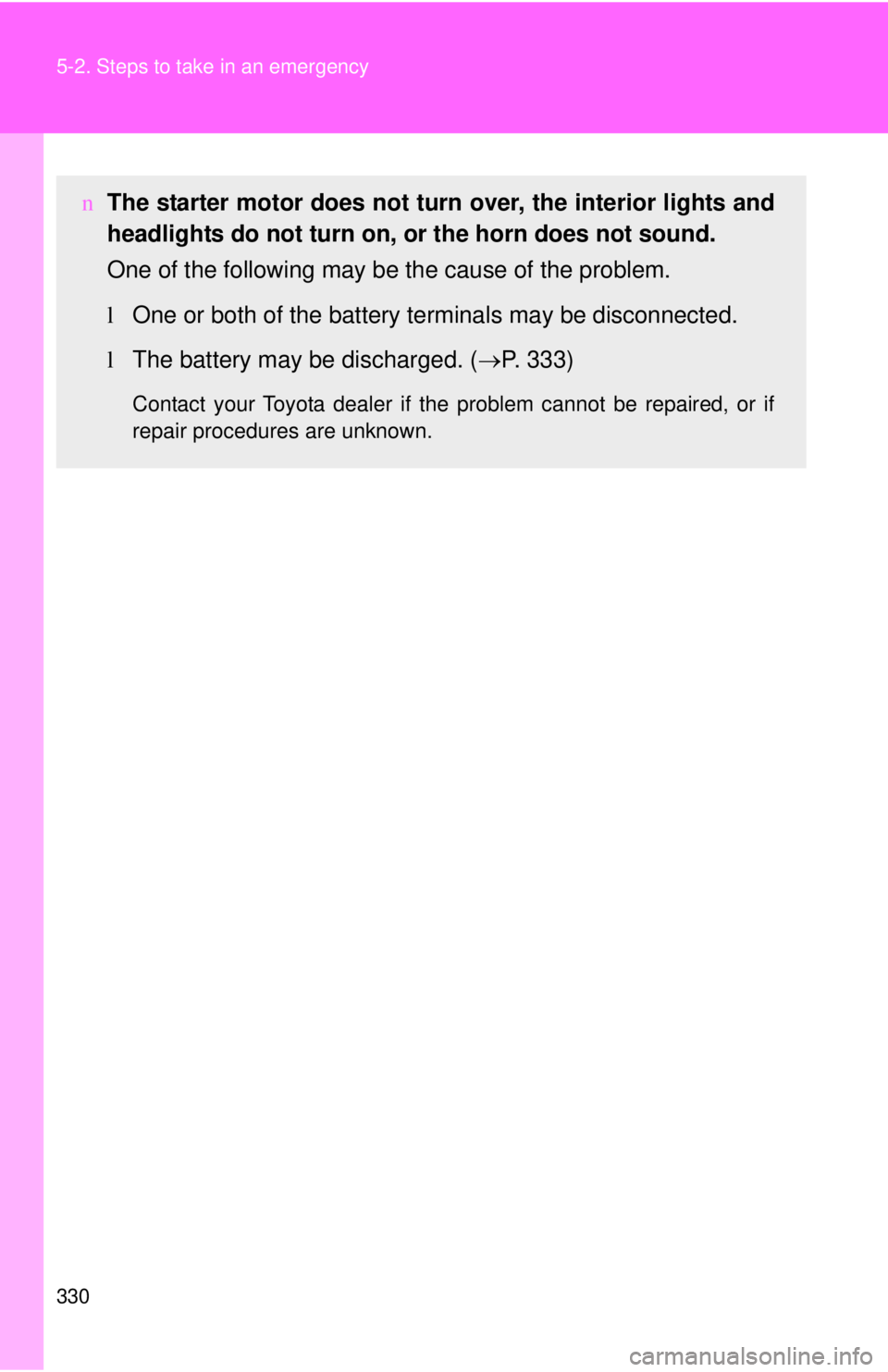
330 5-2. Steps to take in an emergency
nThe starter motor does not turn over, the interior lights and
headlights do not turn on, or the horn does not sound.
One of the following may be the cause of the problem.
l One or
both of the battery terminals may be disconnected.
lThe battery
may be discharged. (→ P. 333)
Contact your Toyota dealer if the problem cannot be repaired, or if
repair procedures are unknown.